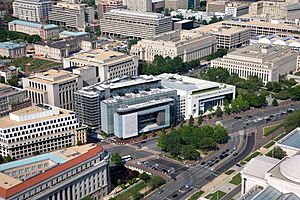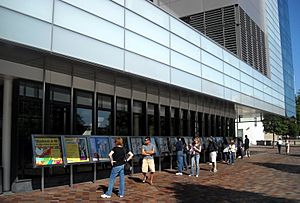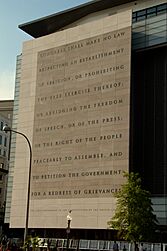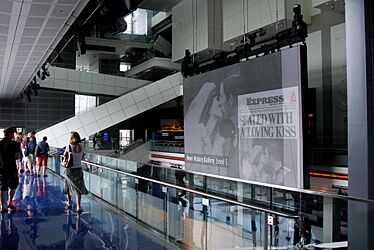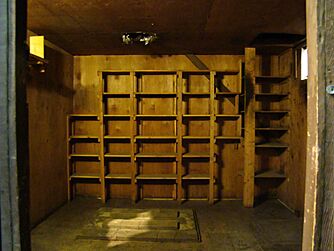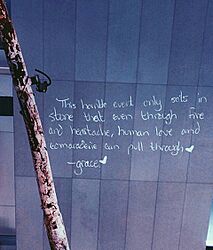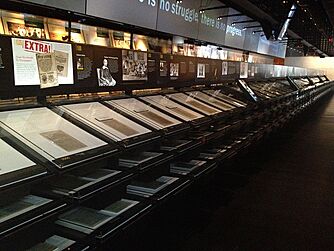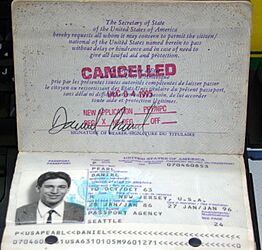Newseum facts for kids
 |
|
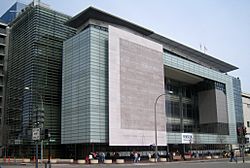
Newseum in 2008
|
|
| Lua error in Module:Location_map at line 420: attempt to index field 'wikibase' (a nil value). | |
| Established | April 18, 1997 |
|---|---|
| Dissolved | December 31, 2019 |
| Location | 555 Pennsylvania Avenue NW Washington, D.C., United States |
The Newseum was a special museum that taught people about news and journalism. It was open from 1997 to 2019. The museum first opened in Rosslyn, Virginia, and later moved to Washington, D.C..
Its main goal was to show how important free speech and a free press are. It also showed how communication has changed over time. The museum was funded by the Freedom Forum, a group that supports freedom of the press and speech. They wanted to help people understand the news better.
The Newseum in Washington, D.C., was a large building with seven floors. It had many theaters and galleries. One popular exhibit showed parts of the Berlin Wall, which was the biggest display outside of Germany. Another gallery showed the front pages of over 80 newspapers from all over the world every day. Some of these daily front pages can still be seen on the Newseum's website. Other exhibits covered topics like the First Amendment, the history of news, and the September 11 attacks.
The museum closed its doors for good on December 31, 2019. Many of its exhibits and items were stored away or sent back to their original owners.
Contents
The Newseum's Journey
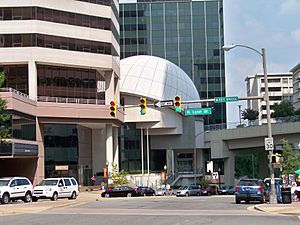
The Freedom Forum is a non-profit group started in 1991 by Al Neuharth. He was the founder of the newspaper USA Today. The Freedom Forum opened the first Newseum in Arlington, Virginia, in 1997. Before this, they had smaller exhibits in Nashville and New York City.
In 2000, the Freedom Forum decided to move the museum to downtown Washington, D.C.. The original Virginia location closed in 2002. This allowed the staff to focus on building the new, much larger museum. The new Newseum cost $450 million to build. It opened to the public on April 11, 2008.
The new building was designed by Ralph Appelbaum and James Stewart Polshek. It had a huge "window on the world" facing Pennsylvania Avenue. This window was 57 by 78 feet and allowed people outside to see into the museum. It also let visitors inside see the National Mall. The 45 words of the First Amendment were carved into a tall stone panel on the building's front.
One important part of the museum was the Journalists Memorial. This was a glass sculpture with the names of journalists who died while doing their job. It was updated every year. The Newseum's website also showed daily newspaper front pages from around the world.
Inside the Newseum Building
The Newseum building in Washington, D.C., was very large. It had a 90-foot-high open space called an atrium. There were seven levels of exhibits, 15 theaters, and many galleries. It also had two broadcast studios.
The building featured a large, oval-shaped theater with 500 seats. It also had office spaces for the Newseum and Freedom Forum staff. The building was known for having some of the largest passenger elevators in the world. These elevators could carry up to 72 people and traveled 100 feet across seven floors. A curved glass memorial honored journalists who had lost their lives.
Special devices kept the air just right for the exhibits. This helped protect the old newspapers and artifacts.
Amazing Exhibits to Explore
The Newseum had many interesting permanent exhibits:
The Great Hall of News
This area was called The New York Times—Ochs-Sulzberger Family Great Hall. In the atrium, a huge 90-foot screen showed the latest news headlines. A replica of a satellite and a helicopter used by a news station were also hanging there.
News History Gallery
The News Corporation News History Gallery showed a timeline of newspapers and magazines. Touch-screen computers let visitors look closely at hundreds of old publications. You could also play interactive games and learn about journalists. This gallery included a 1603 English newspaper and a 1787 copy of the Maryland Gazette. It also had a famous 1948 Chicago Daily Tribune that mistakenly announced, "Dewey Defeats Truman."
Remembering 9/11
The 9/11 Gallery, sponsored by Comcast, showed how news covered the events of September 11, 2001. It honored photojournalist Bill Biggart, who died while reporting on the attacks. Visitors could hear his story and see his last photos. A large wall displayed front pages from around the world published the next day. A piece of the antenna from the World Trade Center was also on display. A film shared stories from reporters and photographers who covered that day.
Pulitzer Prize Photos
The Pulitzer Prize Photographs Gallery showed a huge collection of photos that won the Pulitzer Prize. This prize is given for excellent journalism. It included every winning photo since 1942. Some famous photos included Raising the Flag on Iwo Jima and Burst of Joy. Another showed a firefighter holding an injured baby after the Oklahoma City bombing.
Berlin Wall Display
The Berlin Wall Gallery had the largest display of the original wall outside of Germany. There were eight 12-foot-high concrete sections of the wall. Each section weighed about three tons. A three-story guard tower from Checkpoint Charlie was also part of this exhibit.
First Amendment Freedoms
The Cox Enterprises First Amendment Gallery explored the five freedoms protected by the First Amendment. These are freedom of religion, speech, press, assembly, and petition. The exhibit showed historical news clips that demonstrated these freedoms. Thomas Jefferson once said, "Our liberty depends on the freedom of the press."
Journalists Memorial
The Journalists Memorial honored journalists who died while doing their jobs. This exhibit displayed items from dangerous reporting missions. These included the laptop of Daniel Pearl and the bloodstained notebook of Michael Weisskopf. It also featured the car of Don Bolles that was bombed in Phoenix. More than 1,800 names were carved onto glass tablets, remembering those who died reporting the news.
Gallery
-
The cabin of the Unabomber was on display.
Why the Newseum Closed
The Newseum attracted many visitors each year. However, it faced financial challenges. Even with ticket sales and event fees, the museum lost a lot of money. In 2011, ticket sales only covered 10 percent of its costs.
One reason for these financial problems was the high cost of building the Washington, D.C., location. Also, there are many free museums in the National Mall area, like those of the Smithsonian Institution. This made it hard for the Newseum to charge an entry fee.
In 2018, the Newseum started looking into selling its building. In January 2019, the Freedom Forum announced that Johns Hopkins University would buy the building for $372.5 million. The university planned to use the space for its graduate programs. The Newseum officially closed to the public on December 31, 2019.
The large stone panel with the First Amendment words was removed from the building's front. In 2021, the Freedom Forum decided to donate this panel to the National Constitution Center in Philadelphia. It is planned to be reinstalled there.
The closure of the Journalists Memorial was sad for many people. They felt it was important to remember journalists who died for their work. In 2020, a group in Congress passed a law to create a new memorial for fallen journalists on public land. Design work for this new memorial began in 2023.
See also
 In Spanish: Newseum para niños
In Spanish: Newseum para niños


